|
Departments
eBook now Available!
|
Exclusive - THE book on Traditional & Classic
Siamese cats

Written by the Founder of TCA, Inc.
Tullycrine
Affordable
Web Design
|
|
|
|
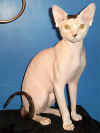
|
Jack
Photos Courtesy of AphroditePaws Cattery
Click on Photos to enlarge
|
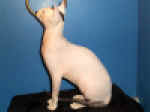
|
FAQ TRADITIONAL SPHYNX CAT
Traditional Sphynx Breeders
HISTORY, HEALTH, PERSONALITY AND CARE
©
Copyright Diana Fineran March 14, 2003
What is the History of the Traditional Sphynx Cat?
The Traditional Sphynx has been recognized as a distinct
breed of domestic cat for many decades. The
first documented report was given by the German naturalist, Johann Rudolph
Rengger in his book, “Natural History of the Mammals of Paraguay”, in 1830.
Rengger said, “This scant-haired cat was the descendant of house cats
taken from Europe to Paraguay in the 1600’s.
The change in climate, he suggested, had gradually effected a change in
coat.”
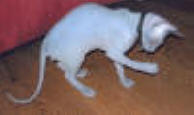 |
Azzaro of Fleur DeLune
Photos Courtesy of
Fleur DeLune Cattery
Click on Photos to enlarge
|
 |
For some time they were called “Mexican Hairless Cats”.
A portrait of a “Mexican Hairless Cat” named, Jesuit, appeared in C.H.
Lane’s “Rabbits, Cats, and Cavies”. In
this account of “The most rare of any species of domesticated cat,” Mr. Lane
quoted a Mrs. Shuick of Albuquerque, New Mexico, who stated, “These cats were
obtained from Indians a few miles from here.
The old Jesuit fathers say they are the last of the Aztec race, and are
known only in New Mexico.” Mrs.
Shuick referred to two cats, a female named Nellie and a male named Dick, who
had been killed recently by several dogs. She
lamented, “His loss was very great and I may never replace him. The Chicago
Cat Club valued him at $1000. I
have sent all over the country and endeavored to get a male for Nellie, but I
fear the breed is extinct.”
Thirty six years later Ida M. Mellen wrote in her
“Journal of Heredity” that she believed the immediate ancestor of the New
Mexican Hairless Cats “undoubtedly was a scant haired cat of South America,”
described by Johann Rudolph Rengger before her. She also suggested that the
hairless cat “may be extinct.”
Still other hairless cats appeared in Wilmington, North
Carolina in 1936, in Paris, France in the 1930’s, and in Ontario, Canada in
the 1960’s and again in 1978.
With only one exception, the parents of hairless cats were
Domestic Shorthairs with no particular bloodlines predominating.
Of interest though were the Paris cats, who had turned up from time to
time in litters born to a certain pair of Siamese cats.
Breeding experiments revealed certain genetic factors.
When the French hairless cats or their parents were bred to other
Siamese, their kittens had normal length coats.
Hairless kittens resulted only from repeat breedings between the original
hairless kitten producing Siamese or from breedings between two hairless cats.
This indicated that the mutation gene responsible for hairlessness is
recessive, at least among cats with normal length coats.
Other experiments were done by crossing Traditional Sphynx to Devon Rex. It was suspected that the Traditional Sphynx gene may be
dominant in Traditional Sphynx-Devon crosses. In any case they are a naturally
occurring mutation that happened many times through out long history.
|

|
Janet
Photos Courtesy of AphroditePaws Cattery
Click on Photos to enlarge |

|
Over time their name evolved from the less flattering
“Mexican Hairless” to the more regal name with the Egyptian flare, the
“Traditional Sphynx”.
A domestic cat gave birth to a single hairless kitten in
Toronto, Canada in 1966.The foundations of the present day Traditional Sphynx
began to be deliberately bred. in 1978. In
1978 an Ontario, Canada Siamese breeder found three hairless stray kittens on
the streets of her town. In 1983
two of the kittens, Punkie and Paloma, were shipped to Dr. Hugo Hernandez in the
Netherlands, where they were bred to a white Devon Rex.
It is believed that the descendents of these cats along with the addition
of descendents of other exceptionally rare mutations are the foundation of
today’s Traditional Sphynx breed.
No weakness of any kind has been found to be connected with
being hairless. For a while it was
hinted that this must be so, but that is untrue. European and North American
breeders have bred the Traditional Sphynx to normal coated cats, then back to
hairless individuals for many decades. Other
comparative selective breedings were done to create a genetically sound cat with
a large gene pool and hybrid vigor. All of these were increased by out crossing to other breeds
as well. In 1985 Walt and Carol
Richards were influenced by an internationally known geneticist, Solveig
Pflueger. The Traditional Sphynx
were in danger of becoming extinct, so Mr. Pfleuger suggested that they be
crossed with the Devon Rex. The
Richards bred one of their Traditional Sphynx males to one of their Devon Rex
females and had a litter of four hairless kittens. They spent years outcrossing
to healthy, unrelated Devon Rex to reach the point where the gene pool was
expanded. While laudable, the work
of the Richards did enable the breed to perpetuate itself, crossing to the Devon
Rex to revive the breed, wasn’t enough for the breed to thrive and flourish.
Experimental crossing to the American Shorthair was conducted as well.
The most distinguishing feature of this rare breed is its
appearance of being hairless. They
truly are not hairless, however. Their
somewhat wrinkled looking skin feels like a soft, warm, suede, hot water bottle.
Some are nearly hairless and others have a fine, virtually imperceptible fuzz or
down on the body. Other descriptions concerning the feel of their skin are like
a warm peach, a horse’s warm muzzle or a heated chamois.
It is acceptable for them to have short, tightly packed soft hair on
their ears, muzzle, nose, feet, tail base and on the tip of their tail. Every
color in the rainbow of cat colors is acceptable.
The color is visible in the skin pigment and on the small amount of hair
they do have.
|

|
Crissy
Photos Courtesy of AphroditePaws Cattery
Click on Photos to enlarge |

|
How is the HEALTH of the Traditional Sphynx ?
The Traditional Sphynx is a very robust cat, which has few
health, or genetic problems and a low kitten mortality rate.
How is the PERSONALITY of
the Traditional Sphynx ?
Their personality has been universally praised across
decades and continents for their demeanor.
In 1903 one anonymous lover of the Traditional Sphynx wrote, “They are
the most intelligent and affectionate family pets I have ever met and the
smartest cats I have ever seen.” The
French describe them as “part monkey, part dog, part child, and part cat.”
Loyal, closely identifying with their human family, they follow people
around, and use their paws like hands. Some
say they are more like people than cats. Their
spirit is more than temperament or personality.
The strength of the Traditional Sphynx is its ability to adapt its
personality to fit the desires of its human companions.
They operate out of their intuitive senses rather than instinct.
With the clarity and innocence of children, they remarkably know what is
really going on in their human environment, regardless of how things actually
look. They can take a place as your
sidekick, provide all the love and attention a person could desire from a pet,
lie on your lap when you are quietly seated,
sown an abundance of energy and mischief, comfort you when you are
feeling low, be sensitive to your disposition, or romp around when your feeling
great. Loving to be looked at, they perform funny antics for mutual
entertainment. Because of their desire to be admired, they are easy to be
handled. The Traditional Sphynx exudes intimacy. Their very nature is to love
and be loved by a human being, via the intensity and devotion to their humans.
It has been said, “These cats are so interactive, so completely satisfying,
entertaining and enchanting that we can’t imagine our lives without them.
In truth these cats are healing by their very nature.
They are instant intimacy in a culture in which true intimacy is almost
impossible to come by.”
The Traditional Sphynx does not enjoy being an only pet.
The company of people, other cats or dogs is their desire.
“They are in reality a gift,” wrote Steve Patterson,
“which when experienced to their fullest capacity, show themselves to be
nothing less than angels in cats bodies!”
|
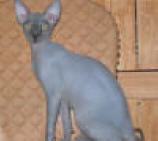 |
Azzaro of Fleur DeLune
Photos Courtesy of
Fleur DeLune Cattery
Click on Photos to enlarge
|
|
How difficult is it to care for the of the Traditional
Sphynx ?
If you are hypoallergenic the Traditional Sphynx may be a
good choice for a pet friend. However, depending on the severity or type of a
persons allergic reactions, some people still can’t live with this breed. The
Traditional Sphynx differs from other cats because they don’t have hair to
absorb the oil the skin produces. Their
dander, which is the usual cause for allergies, tends to remain on the skin
rather than floating freely. The Traditional Sphynx needs to be bathed
periodically with mild shampoo made for cats every so often, which washes the
dander, oil and dust away. It is not difficult with cats who have been
acclimated to being bathed since kittenhood.
It takes little time at all to dry them. Their skin doesn’t dry out as
that of regular cats when they are bathed, so the bathing doesn’t make the
dander more plentiful. If you keep
your hands away from your face, after petting your Traditional Sphynx you should
remain relatively unaware of whatever air born allergens do exist. It is still
advised to acclimate gradually to your cat.
Don’t let the cat in the bedroom or on your pillow until you’ve given
your body time to adjust. If there are any reactions they diminish with time.
There is nothing in nature that is purely hypoallergenic, however.
Yet the Traditional Sphynx seems to come as close as one can get.
Bathing procedures vary.
They can be sponged off in a sink, wiped down with a damp, soft
washcloth, or soaped in a bathtub. Begin
by running warm water that just touches the bottom of the cat’s stomach.
Shallow water gives them more opportunity to move around, so this amount
is best. Be sure to put the total amount of water in first before
putting the cat into the water. Other
wise the cat could be freightened. A
non-skid sink or but liner is best placed on the bottom to protect the cat from
slipping. Use a cup to dampen the
cat. Always keep on hand on our
under the cat to steady it and give reassurance.
A small amount of shampoo goes a long way, so first put the shampoo into
a small amount of warm water in a bowl, then put that diluted mixture on the
cat. Lather and rub the cat, but
avoid its face to keep soap from getting into its eyes, ears or mouth.
Rinsing is so important, because every amount of soap must be removed,
otherwise the cat will have an itchy irritation from any soap residue.
Dry your cat with a warm towel. A
damp, soft cloth is best to wipe off the face.
Always reward your cat for it’s patience with lots of affection.
|

|
Jack
Photos Courtesy of AphroditePaws Cattery
Click on Photos to enlarge |

|
It isn’t surprising that the very intelligent Traditional
Sphynx isn’t as tolerant as a barn cat. Their
extreme sensitivity makes them vulnerable to mistreatment of any kind and even
to negative human environments. They
must be bred and raised respectfully and properly placed in appreciative homes
in order to preserve their essential nature.
Of course, a Traditional Sphynx is NOT an outside cat.
Yes! They can accompany you
on trips, but they must be protected from the elements. Just consider, if it is
too cold for you, then it is too cold for a Traditional Sphynx.
Within their home they seek out a warm dog, cat or human to cuddle up
with. Also, they don’t hesitate
to get under the bed quilts with you.
|
|
|

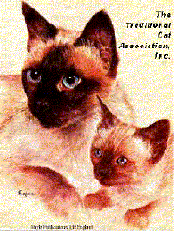 The
Traditional Cat Association,
Inc.©1987®TM
Official Website
The
Traditional Cat Association,
Inc.©1987®TM
Official Website










